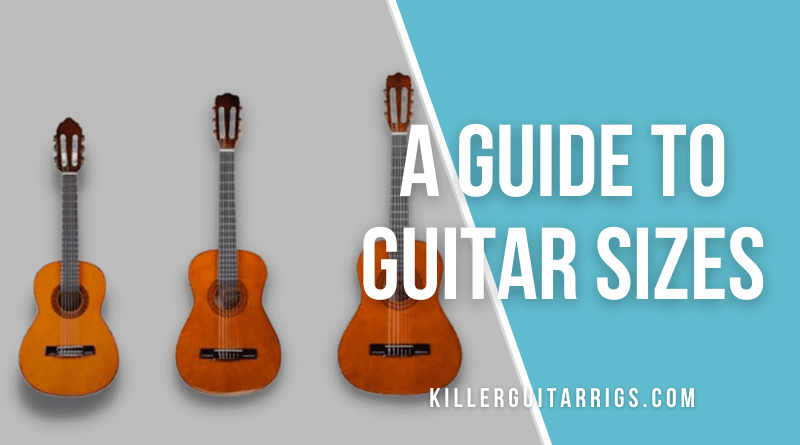The saying that there is a soulmate out there for everyone is also applicable when it comes to finding the right guitar. You may have noticed that different electric guitars are shaped differently, but the difference in sizes is even more visible when it comes to acoustic guitars.
If you are curious about why different guitars are sized differently and which one will potentially suit you the best, then read on to find out more:
Contents
How Do I Measure The Size Of A Guitar?
There are different ways to measure the size of a guitar, here are some of the most common ways to do so.
Total Length
The total length of the guitar refers to the length from the top of the headstock to the end of its body. This is generally not the most reliable way to measure a guitar since guitars may have unique headstocks and body shapes. You generally need the total length of the guitar when you are purchasing accessories such as a guitar case and you need your guitar to fit snugly into them.
Scale Length

The distance from the nut to the bridge of a guitar is known as its scale length. You can also measure the distance from the nut to the 12th fret and double it. This will also give you the scale length.
Typically, the standard size for a ‘full-length’ electric guitar is 25.5 inches whereas basses are 34 inches. The scale length of a guitar often determines its playability.
Neck Width
Another way to measure the size of a guitar is by measuring how wide the neck of the guitar is. Typically, just like lengths, most guitars have a standard neck but many guitar players prefer a thicker or a thinner neck, depending on their playing style and comfort.
While the neck width of a Fender Stratocaster is 1.65 inches, a Gibson Les Paul is thicker at 1.9 inches.
If you play rhythm guitar, a thinner neck will suit you better than a thin neck. If you play solos, a thicker neck is more beneficial.
What Is A ‘Standard’ or ‘Full Sized’ Guitar?
A ‘standard’-sized guitar is around 25.5 inches in scale length and has 19-24 frets. On some acoustic guitars, there is a cutaway to access the higher frets. These are referred to as ‘full’-sized guitars.
There are variations for every brand and every model of guitar because the size of different components will vary.
Size Does Matter
Contrary to what you may have heard, the size of the guitar does matter. This is not because it affects the sound but the size determines how comfortable you would be playing it. When it comes to acoustic guitars, many find the big ‘dreadnought’ guitar bulky and difficult to play. They may prefer something smaller like a parlor guitar.
So let us dig into what the different guitar sizes are and why they are built in a certain way:
Acoustic Guitars
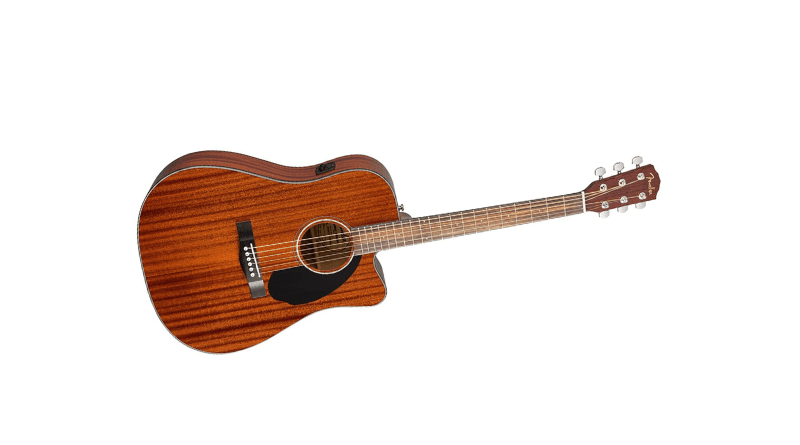
Acoustic guitars can be sized ¼ (48-78cm), ½ (86cm), ¾ (92cm) or 4/4 (full-sized guitar). However smaller sizes do not mean that they are ¼ or ½ in size in comparison to a full-scale guitar. It simply means that the scale length of these guitars is smaller.
In a short-scale guitar, the length is typically around 22-24.75 inches whereas full-scale guitars have are around 25.5 inches in length.
Short-scale guitars are ideal for those who have trouble navigating longer fretboards and want more mobility when playing.
Based on the size, here are some of the most popular types of acoustic guitars:
Guitalele/Guitarlele (¼)
These are very similar to ukuleles because of their size. They have six strings that are tuned to A, D, G, C, E, A and emulate a guitar with a capo on its 5th fret. Their sound is a cross between a tenor ukulele and a classical guitar and a Guitalele is 1/4th size of a standard acoustic guitar.
While these aren’t the best for intricate rhythm patterns and strumming, Guitaleles can yield interesting chord phrasings and can be great if you are looking for a guitar you can easily travel with.
Their small size also makes them ideal for children who want to learn how to play the guitar. They are also called ‘Kikus’. For guitar players, the tuning of the instrument might be confusing at first, but they are treble-heavy and great for fingerstyle guitar.
Brands such as Yamaha, Gretsch, Cordoba, etc are known for manufacturing affordable but high-quality Guitaleles.
Travel
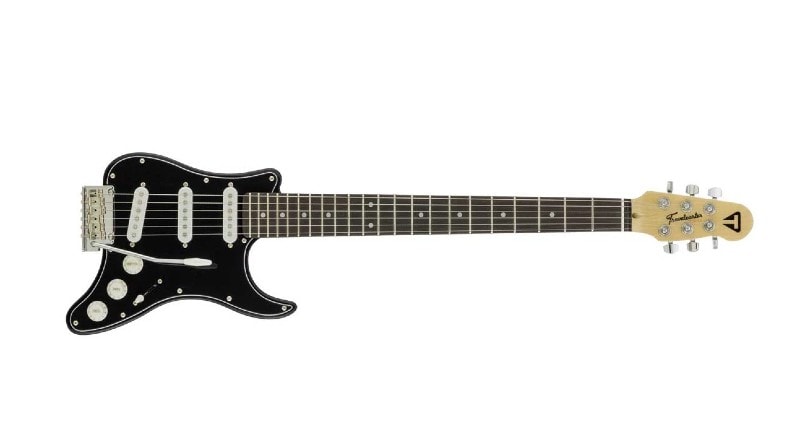
Travel guitars can be short-scaled or full-length, depending on the model. Since they are smaller in size, they are ideal for not just children but also adults who are looking for a guitar they can travel with and isn’t a hassle to carry around.
Travel guitars are also known as ‘baby’ guitars. While models such as the Martin Backpacker or the Washburn RO10 have unconventional body shapes, others such as the Baby Taylor or the Little Martin have regular-shaped bodies that are smaller in size.
In the current context, almost all guitar brands manufacture their version of a travel/baby guitar and you can find a wide variety of them in different budgets. Check out our favorite travel guitars here.
Parlor
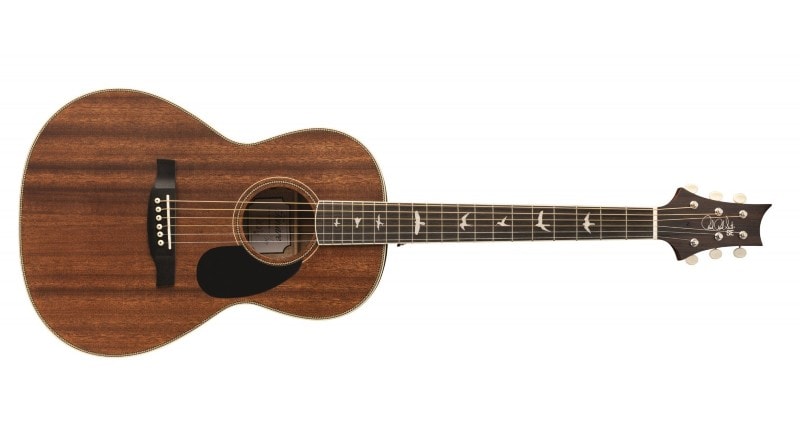
These are the smallest types of acoustic guitar that have a standard nut width. They often have 18 frets and sound the best in intimate spaces.
According to Mottola’s Cyclopedic Dictionary of Lutherie Terms, any guitar that is smaller than current standards can be considered a ‘Parlor’ guitar.
While these were popularised by blues musicians in the 1950s, many brands such as Takamine and Martin have since produced commercially successful models that can be used by musicians who are looking for a great guitar that doesn’t necessarily have to be too loud.
Many modern Parlor guitars also have pickups that can be used to amplify the sound if required.
Parlor guitars generally have a mid-heavy sound and are ideal for not just blues and folk music but also as a fingerstyle guitar or an accompaniment for vocals.
Check out our favorite parlor guitars here.
Concert (O) and Grand Concert (OO) Guitars
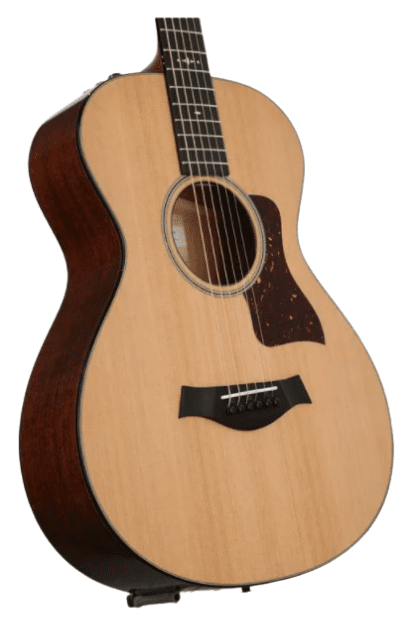
Concert guitars are smaller than dreadnought guitars (we will come to them later) not just because they have a smaller, more tapered body but they also have a slightly shorter neck.
These guitars are visually similar to classical guitars and ideal for the fingerpicking style of playing.
While these aren’t the loudest acoustic guitars available, they are comfortable to play if you have smaller hands.
Concert guitars are generally 18 ¾ inches in length whereas Grand Concert guitars are 18 ⅞ inches. They are slightly smaller than Auditorium guitars.
Auditorium (OOO) and Grand Auditorium (OOOO/OM)
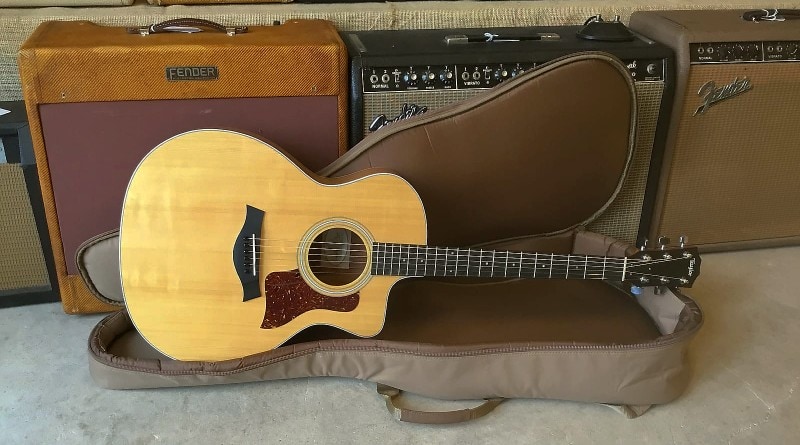
Auditorium and Grand Auditorium guitars are mid-sized acoustic guitars that have an overall balanced sound.
An Auditorium guitar is generally 19 ⅜ inches in length, whereas a Grand Auditorium guitar is 20 ⅛ inches and similar to a ‘Jumbo’ guitar.
These are versatile guitars that can be used for any genre of music or style of playing. Many musicians prefer an Auditorium or Grand Auditorium because they have a narrower waist, thus making them easier to hold.
You can find these across various price points and they are ideal not just for fingerstyle playing but also for strumming.
Jumbo (J)
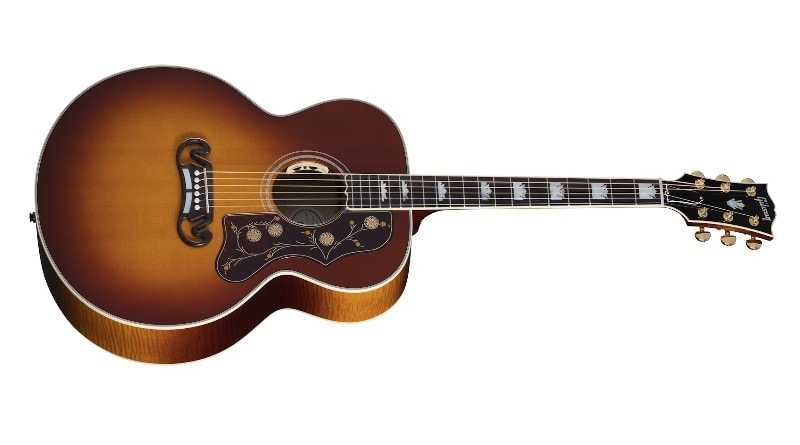
Jumbo guitars have large bodies that allow them to produce large, warm sounds. They are commonly used by pop, country, and rock musicians because they are ideal for strumming.
Like Grand Auditorium guitars, Jumbos are typically 20 ⅛ inches in length. The primary difference between the two is in the shape of the body. The bottom of their body is wider, thus giving them a warmer sound.
While these can be used for any genre of music, many musicians often find it difficult to hold these guitars because of their large size. However, if the size is not a problem for you, then Jumbo guitars are available for every budget.
Dreadnought (D)
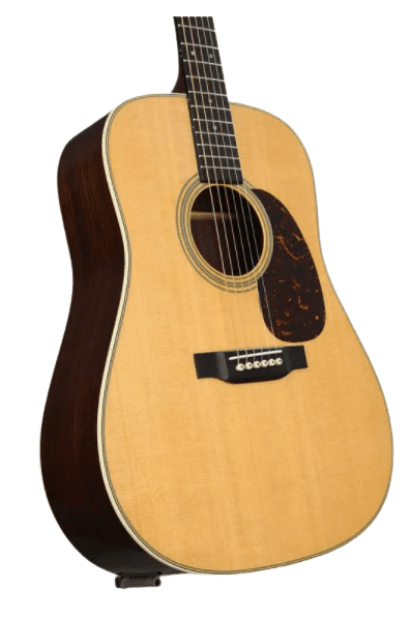
Dreadnoughts were first developed by C.F. Martin & Co. in 1916. While the original models had scalloped bracing, different manufacturers produce their version of a Dreadnought today and some even have cutaways for better access to higher frets.
Since these guitars have a large body, they are known for their loud and bass-heavy sound. The necks of these guitars are generally 43mm, making them narrower than that of an Auditorium or Concert guitar.
A Dreadnought, like the Jumbo, is a versatile guitar. They can be a great fit for beginners and professional musicians alike.
Nylon String
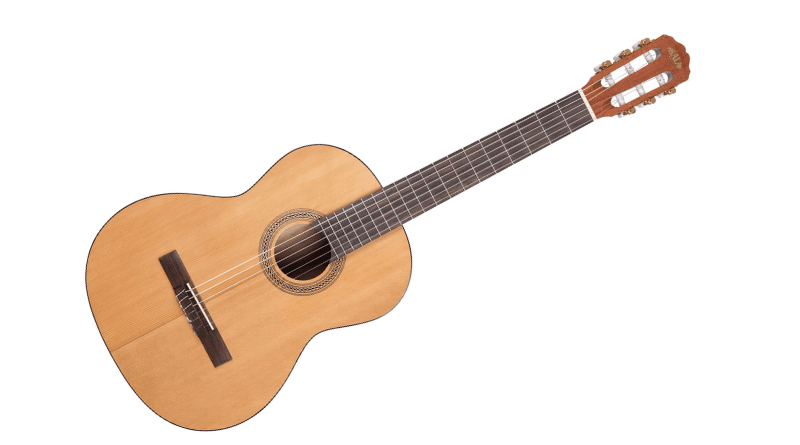
All the acoustic guitars mentioned so far were steel-string guitars. These guitars use nylon strings and have been traditionally used for classical music. While they produce a softer sound, they are ideal for fingerpicking.
While nylon string guitars generally have a standard scale length of 25.6 inches, there are variations available in ½ and ¾.
Nylon string guitars produce a rich, warm sound but unfortunately, they are not as versatile in comparison to a Dreadnought or even a Parlor guitar. They are geared more towards classical musicians.
These guitars are inspired by the ‘baroque’ guitars of the 18th century.
Size and Sound
So now that you know about the different types of acoustic guitars, the main question you may have is how does the size of a guitar affect its sound?
To put it simply, in an acoustic guitar sound is produced when the vibrations from the strings resonate throughout the top of its body when it is transmitted from the bridge. The vibrations resonate through the air in the body and can finally be heard through the soundhole.
This means that the larger the body, the more the resonance and thus the warmer the sound. This is why a Jumbo or a Dreadnought produces bass and low-end rich sounds whereas a Parlor guitar is more treble-heavy.
Also, the larger the body of an acoustic guitar, the louder the volume of sound it can naturally produce, without any external amplification. However, the difference is more noticeable in the kind of sound an acoustic guitar produces than its volume.
If you are looking for the best acoustic guitar for beginners, then you can read our review here.
Electric Guitars
While electric guitars may not be as varied as acoustic guitars in terms of different sizes, the total length varies depending on the type of body they have.
Short Scale
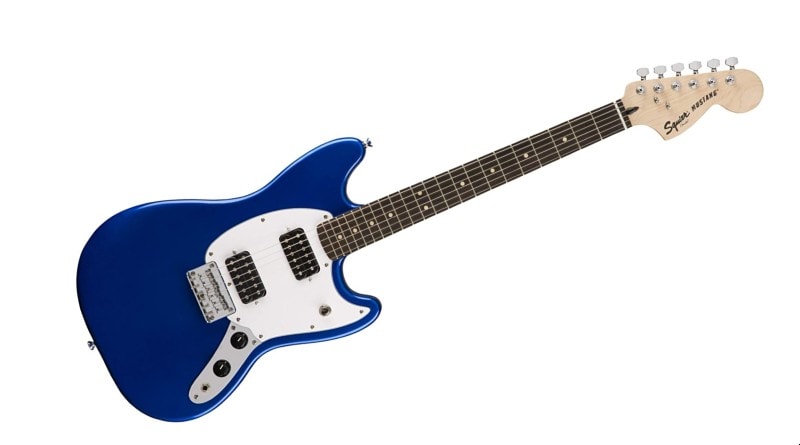
These guitars, as explained earlier, have a shorter scale length. This results in lower tension and smaller fret spacing. One can thus comfortably navigate their way around the fretboard even if they have smaller hands.
Short-scale guitars come in many different forms. You can read more about them here.
Travel

Although not as common as the other types, many brands manufacture travel electric guitars. They are usually ¾ scale and have lightweight bodies, making them less bulky than a regular electric guitar.
While these are more of a novelty, guitars such as Steiberger’s ‘Spirit’ or Yamaha’s ‘Silent’ SLG200S have unusual-shaped bodies that make them easy to travel around with.
In terms of sound, unlike Junior or Short-Scale guitars, Travel guitars are often limited in terms of versatility.
Junior
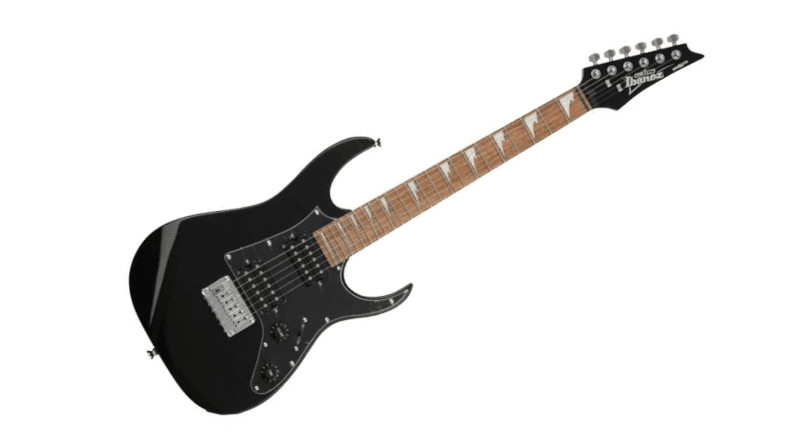
Junior guitars such as the Ibanez ‘Mikro’ or the Squier Mini Jazzmaster may be targeted towards children who want to learn the guitar, but they can be surprisingly useful for adults too.
These guitars have narrower frets, smaller bodies, and are often short-scale.
One of the reasons these guitars are popular is because children often find it difficult to play full-sized electric guitars because of their large size and their weight. While a Gibson Les Paul Junior weighs around 7lbs, the full-sized version can be as heavy as 9-12lbs.
Junior guitars are not just smaller in size, but they are significantly lighter to hold.
Solid Body

Most guitars such as the Fender Stratocaster and Telecaster or the Gibson Les Paul are Solid Body guitars. These generally have a 25-inch scale and are 38 inches in total length. Bass guitars have a longer scale length, generally 34 inches.
While there are variations in neck width and body shape, these are considered the standard guitar size.
There is a wide range of solid body guitars to choose from. A guitar player takes into consideration their sound and the genre they want to play when they buy one. They can be used to play rhythm, lead, or both.
Hollow Body

Unlike Solid Body guitars, these have cutaways on the body and are also known as ‘Thinline’ or ‘Semi Acoustic’ guitars (check out our favorites here).
They usually have a standard scale length but unlike Jumbo or Dreadnought guitars, they are lighter in weight.
These guitars are best for genres such as jazz and blues due to the high level of gain in the sound they produce.
Long Scale VS Short Scale
Both have their advantages and disadvantages. Long scales have higher string tension when compared to short-scale guitars, this makes the latter easier to play. However, as the name suggests, a long-scale guitar is often best suited for genres such as metal where one can play additional notes or more unique phrasings.
If you like alternative tunings, a long-scale guitar will help you achieve a deeper sound without heavier string gauges. However, for a simple drop-D tuning, a standard or a short-scale guitar is sufficient.
Choosing The Right Electric Guitar
Unlike acoustic guitars, there are multiple factors you have to take into consideration when you buy an electric guitar and the size is only one of them.
You should be able to comfortably hold your guitar and navigate the fretboard with ease. But you also need to think about the genre of music you want to play. While a Stratocaster can be great for rock, blues, and funk, heavier genres need a guitar with a more treble-heavy sound.
While all guitars are for everybody, if you have trouble playing a full-sized guitar, then you can look for a short-scale equivalent of the model. Manufacturers such as Ibanez, Fender, Gibson, etc make many short-scale guitars that give you the same sound as the standard sized models.
Guitars For Children

Kids may find it difficult to hold a full-sized acoustic or electric guitar. If you want to buy your children a guitar, you can get them started on ½ or ¾ scale guitars they can learn the basics on. They can always graduate to a full-sized guitar when they grow.
But this depends on the child. Many kids are comfortable playing full-size guitars as well. A guitar, whether electric or acoustic, with a smaller body is generally a safe bet because they tend to be less bulky and your child will be able to hold them with some practice.
Frequently Asked Questions
Is a baritone guitar bigger?
Yes. They typically have a scale length of 27-30 inches and have longer necks. Baritone guitars don’t necessarily have a larger body.
What is the best guitar size?
The best size depends on the individual playing the instrument and the genre they play. As explained, different guitars serve different purposes and you need to choose one that fits you best.
Can beginners play full-size guitars?
Yes, absolutely. While short scale, ½, or ¾ scale guitars are targeted towards those with smaller hands, it does not mean that you cannot play a full-size guitar if you are petite and a beginner. You will be able to play any kind of guitar if you practice dedicatedly.
What is ‘nut width’?
The length of the nut or the first fret is known as the ‘nut width’. It is measured in millimeters.
Final Thoughts on Guitar Sizes
Each guitar is unique and serves a different purpose. When it comes to acoustic guitars, you should consider how loud you want to play. Jumbos and Dreadnoughts are known for their volume and warm sound whereas Parlor or Concert guitars are best for fingerstyle playing.
When it comes to electric guitar, choose one that sounds the best rather than its shape or size. At the end of the day, playing guitar has a lot to do with muscle memory. So pick the one you are comfortable with and then practice regularly to get used to the fretboard and the body.
Check out these other articles you might like:

